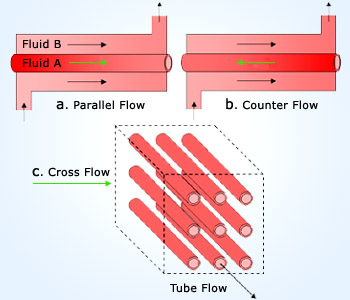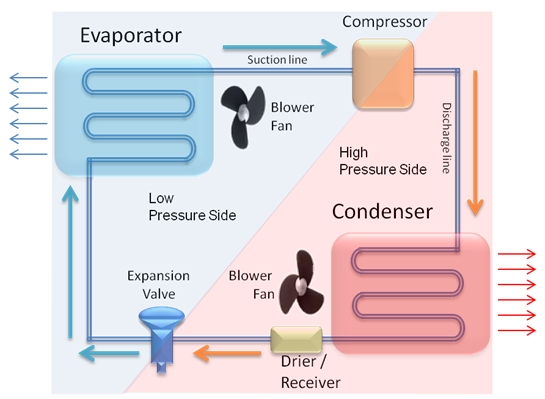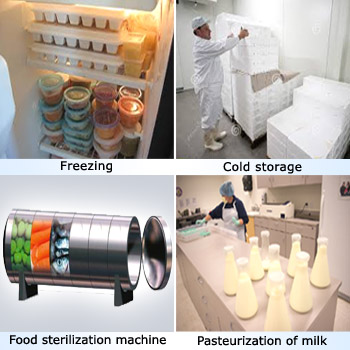
The principles of heat transfer are widely used in the food–processing industry. Heat exchangers such as boilers, pasteurizers, freezers, chillers, coolers, ovens, air heaters, jacketed pans etc. are deployed to transfer heat energy from one body to another. Often, one or both the bodies that are exchanging heat are fluids. They flow continuously in the heat exchange equipment and acquire or release heat in doing so. Normally fluid 'A' is passed through pipes or tubes and fluid 'B' is passed around them.
Ex: Cooling of milk.
-
Parallel flow: both the fluids flow in same directions. Fig(a).
-
Counter flow: they flow in opposite directions. Fig(b).
-
Cross flow: they flow perpendicular to each other. Fig(c).
The flow of fluids in the heat exchangers is of 3 types.

Refrigeration is a process for obtaining low temperatures. A mechanical refrigeration cycle is illustrated in the adjacent figure.
- Evaporator
- Compressor
- Condenser
- Receiver/Drier
- Expansion device
An air conditioning system comprises five major components:
The five major components are divided into two pressure regions: the high-pressure side is the condenser and receiver/drier unit.
The low-pressure side is the air conditioning evaporator. The dividing point between high and low pressure cuts through the compressor and the expansion valve.

Chilling is a process by which the temperature (of foods etc.) is reduced to derived temperature above the freezing point. It slows down the deterioration / decay of foods.
Ex: chilling of fresh apples.
Freezing process involves removing of latent heat of water (present in the foods).
Ex: freezing of fish or slabs of meat.
Deterioration or decay of foodstuffs depend on temperature. The growth of micro organisms virtually ceases at low temperatures for which the water present has to be frozen.
In cold storage, the refrigeration requirement is to remove three main sources of heat from:
- Surroundings into the storage area through the insulation provided.
- Motors, lights, people with in the store.
- The foodstuffs.
Sterilization is the process of destroying microorganisms (bacteria, yeast, mounds) in food materials by heating to prevent decomposition.
Ex: all canned foods undergo sterilization.
Pasteurization also is a heat treatment of food (but less drastic than sterilization) to inactive pathogenic organisms specific to a food.
Ex: pasteurization of milk.
Contributed by: Mr.K Ramesh